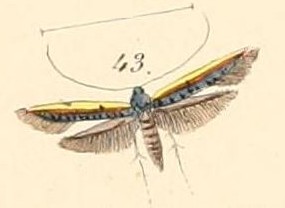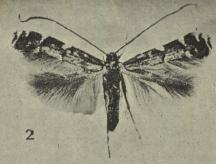
Stigmella hoheriae is a species of moth of the family Nepticulidae. This day flying moth is found in New Zealand in both the North and South Islands. It inhabits native forest. Eggs are laid on the surface of a still growing leaf of a host plant. Larvae feed on Hoheria species such as Hoheria glabrata, Hoheria populnea, Hoheria sexstylosa and Hoheria angustifolia and have been recorded from February to August. The larvae of S. hoheriae are leaf miners. Their mines create blotches on the host plant leaves. S. hoheriae larvae pupate in a silk cocoon on the ground at the base of their food plant. Adult moths have been observed on the wing in February and from July to December. This species is rarely noticed as it is very small and as a result does not tend to attract attention when on the wing.

The European oak leaf-miner or Zeller's midget is a moth of the family Gracillariidae. It is found in Europe south of the line running from Ireland, through Great Britain, Denmark to Ukraine. It is also found in Macaronesia. It is an introduced species in New Zealand and Australia.

Acrocercops alysidota is a moth of the family Gracillariidae. It is known from New South Wales, Queensland, Victoria, Southern Australia and Western Australia as well as New Zealand.
Macarostola ida is a moth of the family Gracillariidae. It is known from Australia in the states of New South Wales, Queensland, Western Australia and Victoria. In 2019 it was discovered to have become established in Northland and east Auckland in New Zealand.

Eumetriochroa hederae is a moth of the family Gracillariidae. It is known from the islands of Honshū, Kyūshū, Shikoku in Japan and in China.
Acrocercops aethalota is a species of moth of the family Gracillariidae, known from New Zealand. In 2019 Robert Hoare proposed that this species be provisionally assigned to the genus Eumetriochroa. However as this proposal needs further investigation this species is also currently known as Eumetriochroa (s.l.) aetholata.
Porphyrosela hardenbergiella is a moth of the family Gracillariidae. It is known from New Zealand, but may be adventive, since the host plant is Australian. The colony known to Wise has been destroyed since its discovery. This species was last collected in New Zealand in 1955 but as at 2019 was still not known from Australia.
Caloptilia chalcodelta is a moth of the family Gracillariidae. It is endemic to New Zealand. The larvae of this species mine and fold leaves of species in the genus Nestegis.

Caloptilia chrysitis is a moth of the family Gracillariidae. It is endemic to New Zealand. The larvae of this species mine and fold the leaves of species in the genera Weinmannia andElaeocarpus as well as Knightia excelsa, although only rarely for the later species.

Caloptilia elaeas is a moth of the family Gracillariidae. It is known from New Zealand.

Caloptilia selenitis is a moth of the family Gracillariidae. It is known from New Zealand.

Caloptilia linearis is a moth of the family Gracillariidae. It is known from New Zealand.
Caloptilia scutellariella is a moth of the family Gracillariidae. It has been recommended that this species be further studied as its placement within the genus Caloptilia is in need of clarification. It is known from Ontario, Canada, and Ohio and Michigan in the United States.

Acrocercops leucocyma, also known as the kauri leafminer, is a species of moth in the family Gracillariidae. It is endemic to New Zealand.

Acrocercops zorionella, also known as the karamu leafminer, is a species of moth in the family Gracillariidae. It is endemic to New Zealand.

Acrocercops panacitorsens is a moth of the family Gracillariidae. It is known from New Zealand. In 2019 Robert Hoare proposed that this species be provisionally assigned to the genus Eumetriochroa. However as this proposal needs further investigation this species is also currently known as Eumetriochroa (s.l.) panacitorsens.

Acrocercops panacivermiforma is a moth of the family Gracillariidae. It is known from New Zealand.

Acrocercops panacicorticis is a moth of the family Gracillariidae. It is known from New Zealand. In 2019 Robert Hoare proposed that this species be provisionally assigned to the genus Eumetriochroa. However as this proposal needs further investigation this species is also currently known as Eumetriochroa (s.l.) panacicorticis.

Acrocercops panacifinens is a moth of the family Gracillariidae. It is known from New Zealand. In 2019 Robert Hoare proposed that this species be provisionally assigned to the genus Eumetriochroa. However, as this proposal needs further investigation this species is also currently known as Eumetriochroa (s.l.) panacifinens.

Acrocercops panacivagans is a moth of the family Gracillariidae. It is known from New Zealand.






